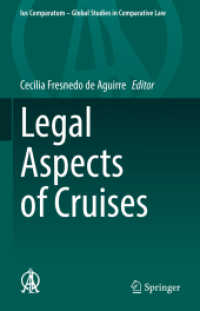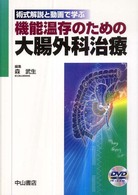- ホーム
- > 洋書
- > 英文書
- > Science / Mathematics
Full Description
Edible oils and fats are derived from plants and animals and have several health benefits. Edible oils and fats consist of many health-promoting bioactive compounds such as polyunsaturated fatty acids, monounsaturated fatty acids, polyphenols, flavonoids, phytosterols, vitamins, and inorganic compounds. The chemical compounds present in edible oils and fats are known for their possible health risks such as coronary heart disease and metabolic diseases, which is why there is a need to check the quality, purity, and safety of edible oils and fats. Bioactive Compounds of Edible Oils & Fats: Health Benefits, Risks, and Analysis provides an overview of different edible oils and fats, health benefits, associated risks, and analytical techniques for qualitative and quantitative guidelines for ensuring their quality and safety using modern analytical tools and techniques. This book will provide an important guideline for controlling quality, safety, and efficacy issues related to edible oils and fats.
Key Features:
Provides a detailed overview of different edible oils and fats of plant and animal origin, chemistry, and identification methods.
Describes their health benefits, risks, and the use of different analytical techniques in quality control.
Describes the applicability of sophisticated analytical techniques such as GC-FID, GC-MS, and HPLC for quality control of edible oils and fats.
Emphasizes the use of recent techniques such as LC-MS and FTIR-chemometrics in the analysis and quality control of edible oils and fats.
Contents
Section I: General Introduction, Sources, and Chemistry 1. Edible Oils & Fats: An Overview 2. An insight into the chemistry of edible oils and fats bioactive constituents 3. Isolation and Characterization Techniques of Bioactive Compounds of Edible Oils & Fats Section II: Health Benefits and Risks of Bioactive Compounds of Edible Oils & Fats 4. Mono-saturated and Polyunsaturated Fatty Acids 5. Saturated Fatty Acids 6. Triglycerides 7. Polyphenols and flavonoids 8. Phospholipids 9. Phytosterols Section III: Adulteration and Quality Control Methods 10. Vitamins and Inorganic compounds 11. Adulteration in Edible Oils & Fats 12. General quality control methods for Edible Oils & Fats 13. GC/FID in Analysis of Edible Oils & Fats 14. GC/MS in Analysis of Edible Oils & Fats 15. HPLC & LC/MS in Analysis of Edible Oils & Fats 16. FTIR-Chemometrics in Analysis of Edible Oils & Fats 17. Packaging and labeling policies for bioactive constituents from edible oils and fats; a global perspective 18. Bioactive constituents of edible oils and fats; ongoing trends of application cum consumption and commercial potential 19. Healthy living with bioactive constituents obtained from fats and oils; Therapeutic concern.








